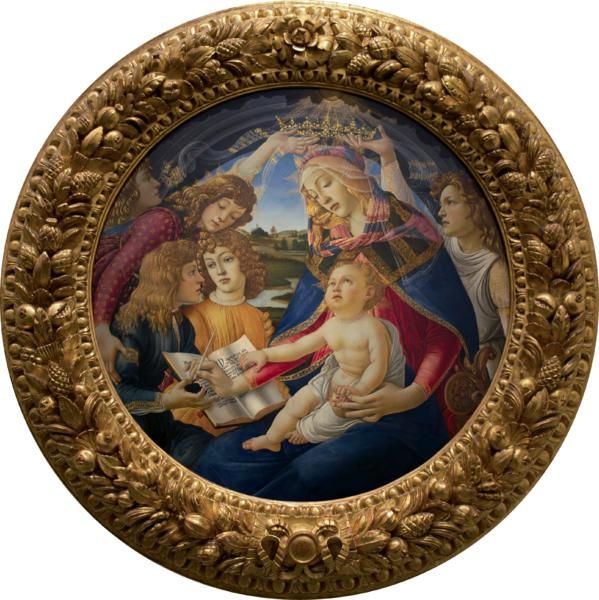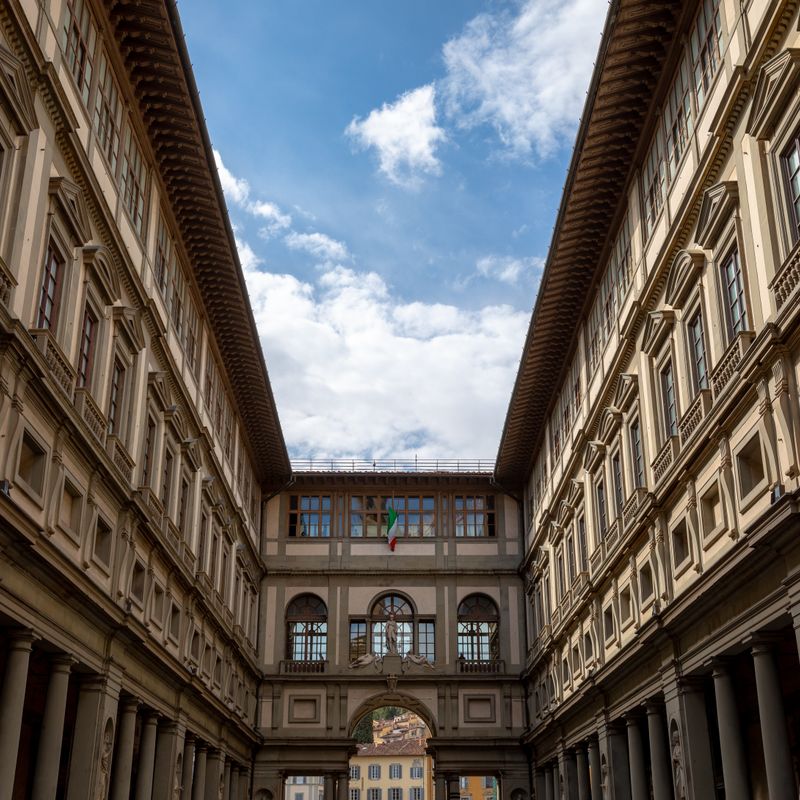
Madonna of the Magnificat
The Madonna of the Magnificat (Italian: Madonna del Magnificat), is a painting of circular or tondo form by the Italian Renaissance painter Sandro Botticelli. It is also referred to as the Virgin and Child with Five Angels. In the tondo, we see the Virgin Mary writing the Magnificat with her right hand, with a pomegranate in her left, as two angels crown her with the Christ child on her lap. It is now in the galleries of the Uffizi, in Florence.
History
The history of the painting is not known, but the Uffizi acquired it from a private collection in 1784. It may have come from one of the many monasteries suppressed by the Archduke Pietro Leopoldo. There are several copies of the painting, including one in the Louvre and one in the Morgan Library & Museum in New York. In the Louvre's copy, the leftmost angel, crowning the Virgin, is erased, leaving room for a large spread of wings for the highest angel in the trio to the left.
Description
The work portrays the Virgin Mary crowned by two of five angels, a sheer veil covering her flowing blonde hair and a Byzantine style scarf around her shoulders. She is writing the opening of the Magnificat on the right-hand page of a book; on the left page is part of the Benedictus. As Mary writes in the Magnificat, the infant Jesus guides her hand, looking up to the clear blue sky, or perhaps to his mother, softly returning his gaze. In her left hand she holds a pomegranate. The figures are placed in front of a bright and serene landscape, and the framing creates a division between Heaven and earth. To the left, three angels crowd around the Magnificat, seemingly in deep conversation amongst one another.
The Magnificat, a canticle also known as The Song of Mary, is taken from the Gospel of Luke (1:46-55). In this narrative, Mary is visiting her cousin, Elizabeth, who is pregnant with John the Baptist. As John moves within Elizabeth's womb, Mary praises God for the favor he has bestowed upon her. The Benedictus, also known as The Song of Zechariah, is another canticle taken from the Gospel of Luke (1:68-79), and was the song uttered by Zechariah during the circumcision of his son, John the Baptist.
Many art historians have debated that Mary is thought to be a portrait of Lucrezia Tornabuoni, wife of Piero de' Medici, and the two angels holding the book to be her sons Lorenzo and Giuliano.
In Giorgio Vasari's The Lives of the Most Excellent Painters, Sculptors, and Artists, Vasari states:In the Guardaroba of the Signor Duke Cosimo are two very beautiful female heads in profile by this master, one is said to be the portrait of an inamorata of Giuliano de' Medici, brother of Lorenzo; the other that of Madonna Lucrezia Tornabuoni, Lorenzo's mother.
However, there are no reliable sources that definitively recognize this portrait as the Madonna of the Magnificat, so this hypothesis is largely disregarded. The identity of the Madonna is unknown, and may simply be one of the many generic Madonna figures that Botticelli painted throughout his career.
1483
Tempera on panel
118.0 x 118.0 cm
00188562
Image and text courtesy of Wikipedia, 2023
Where you'll find this

Galleria degli Uffizi
Permanent collection




